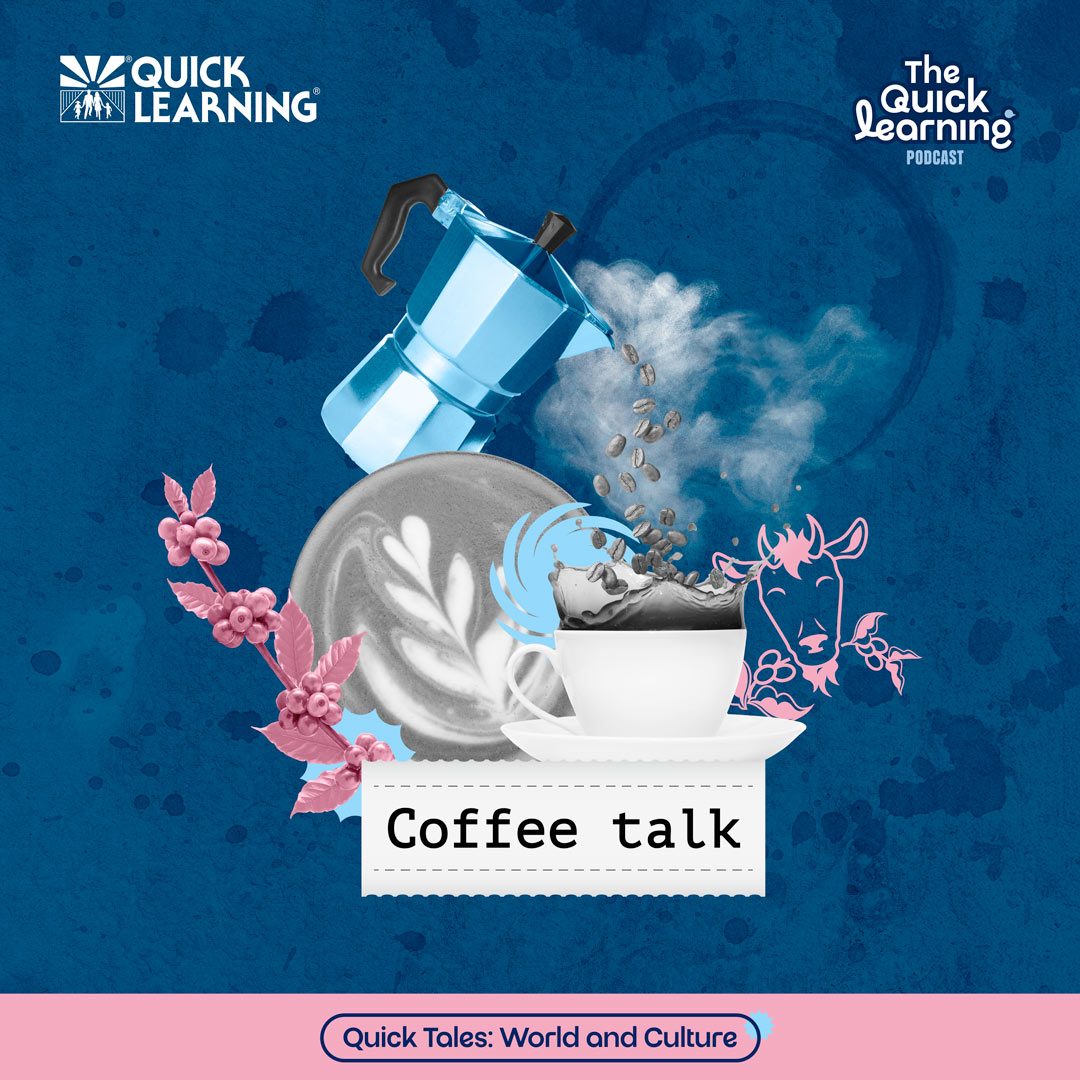
Mmm… That first sip of coffee, absolutely unbeatable.

See, I actually think the second sip is better. The first one is just waking up your system. But the second? That’s when you really taste it.

Okay, interesting theory. But I’m sticking with the first sip as the best moment.

Alright, we’ll agree to disagree. Either way, we clearly take our coffee way too seriously.

No arguments there.

Hey everyone! Welcome to The Quick Learning Podcast, where we sip coffee and chat about fun ways to improve your English. I’m Teacher John, currently on cup number… uh, four? Maybe five? I lost track.

It’s only excessive if your hands start shaking.

Uh-oh. That explains a lot.

I’m Teacher Emma, and since we’re sitting in a coffee shop, what better topic to dive into than coffee itself? How it helps with learning English, some weird history, and the coffee culture that’s taken over the world.

Exactly! Coffee isn’t just a drink it’s a whole experience. It’s become a huge trend, from the way people order to the vibe of coffee shops.

Right? Just think about how many people use coffee shops as a meeting point. You don’t just grab a coffee and go you sit, you chat, you work, you people-watch. It’s like a modern-day town square.

Yeah! Especially in the U.S., coffee shops are where everything happens. Business meetings, study sessions, dates even just casual conversations with strangers.

And the way people order has become part of the culture too. Everyone has their own “perfect” order oat milk, extra foam, half-sweet, iced, triple shot…

Exactly! And for English learners, ordering coffee is actually a great way to practice real-life conversations.

Why does it have to be so hard? You’re not giving a speech; you’re just ordering a drink. It’s low pressure! “Can I have a cappuccino, please?” or “I’d like an iced latte.” Boom! You just used English. Now that we can agree on!

And if you want to extend the conversation, ask a question! “What do you recommend?” or “Do you have oat milk?” Simple as that! That way, you’re actually interacting with the barista instead of just placing an order like a robot.

Exactly!

And let’s be real, this is the kind of English you actually use in daily life. Nobody walks around saying, “The cat is on the table.” But ordering coffee? That’s essential.

So true. And sometimes, baristas throw in a question that totally catches people off guard. I speak from experience.

Oh, like “For here or to go?” That one confuses people all the time.

Right? It’s such a simple question, but I’ve seen people freeze when they hear it. Not that it’s ever happened to me…

Are you sure, Emma? It just means “Are you staying or taking it with you?” And the answer is easy: “To go, please.” or “For here, thanks.”

I know! But I get nervous because I’m so indecisive. I never know where I want to drink my coffee.

Okay, fair enough. And honestly, coffee shops are great places for English learners to just listen. Hear how people place their orders, how they say “thank you,” how the barista responds. It’s like free listening practice.

What about you, listening to us right now? When do you feel like you could practice your English the most in a coffee shop?

Let us know in the comments!

John, did you know coffee actually started with goats?

Wait, what?

Yep! Coffee was first discovered in Ethiopia by a goat herder named Kaldi. He noticed his goats got super hyper after eating these red berries. So he tried them himself, felt super energized, and boom coffee was born.

Hold on. You’re telling me hyper goats invented coffee?

Pretty much! And from Ethiopia, coffee spread to the Middle East, where people started drinking it in coffeehouses.

Oh yeah, I’ve heard about those. They weren’t just places to grab a drink. They were like the original social media people met up, talked politics, shared news, even listened to music.

Kind of like today!

Exactly. Then coffee made its way to Italy, where espresso culture took off. Italians don’t sit around with giant lattes they take a quick espresso shot, maybe chat for a second, and then they’re off.

I like that! It’s straightforward and even saves time, don’t you think?

Maybe! But now look at France completely the opposite.

Why’s that?

Coffee in France is practically an event. You sip it slowly, eat a croissant, and just watch the world go by.

Totally different from the U.S., where you grab a coffee and rush off to your next thing.

Tell me about it. France sounds dreamy.

I think I still prefer Italy. It suits me.

Yeah, you’re always straight to the point. I’d take France, no doubt. I like to enjoy every sip of my coffee.

Don’t worry, John. I think you’ll have plenty of sips today.

Oh! Do you know about Sweden’s fika? That’s next level.

Oh yeah! Fika isn’t just a coffee break it’s a ritual. You stop everything, sit with friends, and actually enjoy coffee and pastries. No rushing.

Take me to Sweden, ASAP!

Meanwhile, in Turkey, they boil coffee in sand.

Yeah… I still don’t get that.

It’s all about controlling the heat! Turkish coffee is super rich and thick, and they take the whole brewing process very seriously.

I respect that. But I draw the line at reading fortunes in coffee grounds.

Oh, come on, that’s fun! You drink your Turkish coffee, flip the cup upside down, and someone “reads” the patterns in the grounds.

My fortune would just say, “You drink way too much coffee.”

Probably. Speaking of, let’s settle this is coffee actually good for you?

Oh boy. Okay, I want to say yes, but I also drink so much of it that I might be biased.

I’d love to hear what our listeners think what do you say? Is coffee good for your health?

So…?

Well, science says coffee has tons of benefits. It boosts brain function, improves memory, and even lowers the risk of diseases like Alzheimer’s and Parkinson’s.

Alright, I like where this is going.

But too much coffee can make you anxious, mess with your sleep, and cause heart palpitations.

Yeahhh, I know that feeling. But honestly? Still worth it.

Moderation, John. It’s all about moderation.

I know.

Ok, what about brewing methods? Best way to make coffee?

Pour-over, no contest. It’s clean, smooth, and you really taste all the flavors.

See, I like the French press richer flavor, more texture. Speaking of, I’m going to order another one.

Go ahead! Meanwhile, let us know your favorite brewing method in the comments!

Mmmm… delicious. Nothing like the third coffee of the day.

I know exactly what you mean. Bad coffee is the real enemy here.

Now that we can agree on.

Challenge time! Next time you’re at a coffee shop, try ordering in English. Say, “Can I have…?” or “I’d like…” —and pay attention to how the barista reacts. You never know, you might start a conversation!

Or better yet, grab your coffee, sit back, relax, and listen to more episodes of The Quick Learning Podcast.

Oh, absolutely! And if you want to take it a step further, why not practice English with a Quick Learning teacher? Just head to QuickLearning.com to find out how!

Thanks for hanging out with us! If you enjoyed this episode, leave us a review and share it with a fellow coffee lover.

Until next time, enjoy your coffee and your conversations. Bye, everyone!













































































